Automation creates opportunity in logistics real estate
Rapid adoption of warehouse automation technologies is helping logistics customers tap potential in urban areas and make strides in e-fulfillment, research shows.

The accelerating adoption of warehouse automation technology is creating a wave of change in the industrial real estate market, especially when it comes to tapping the potential of urban markets and making strides in e-commerce fulfilment. That’s according to a research paper from logistics real estate giant Prologis, released Wednesday.
This first in a two-part series on warehouse automation aims to help logistics customers understand the converging trends that are driving the adoption of new technologies and explain how customers can prepare to take advantage of those trends in 2021. Rapidly increasing e-commerce activity, labor-related challenges due to Covid-19, and steadily improving technology solutions are converging to make this a top issue in the industrial real estate market, according to Prologis.
“I think the key takeaway here is [that] this is all the product of a lot of change that’s happening all at once,” Melinda McLaughlin, head of Prologis’ research team, said in an interview about the report. “There’s going to be the need for more logistics space, close to end consumers—especially modern [facilities] that can accommodate [warehouse automation].”
The trend is being punctuated by a slowdown in construction that could create a crunch for logistics real estate in 2021.
“These [trends] are all coming to a head at the same time that we’ve seen construction slow down,” McLaughlin added. “[The] likelihood of a critical shortage of space to accomodate all this is real.”
Three key points highlight the overall warehouse automation trend, according to the research:
-
The adoption of automation within logistics facilities has rapidly accelerated–what was expected to take years to gain traction is occurring in mere months. Adoption of one or more types of automation technologies is between 20% and 25% across logistics real estate facilities.
-
Covid-19 has accelerated the growth of e-commerce operations, which is three times more labor intensive compared to traditional logistics operations and has twice the volatility in sales compared to brick-and-mortar retail. Automation can improve labor productivity and smooth out peaks.
-
Automation can help unlock urban distribution center locations where labor costs and availability have traditionally been hurdles–it spurs opportunities for expansions into markets with limited labor pools.
McLaughlin said Prologis clients are starting to experiment with micro fulfillment technologies—especially in urban locations—as they seek to put more inventory in close proximity to customers and reduce their reliance on labor. She said she expects that trend to continue in 2021.
“I think the diamond in the rough here is finding a modern facility in a great location,” she said. “Once you start to have more independence in your location choice—and automation does open up that possibility—you can start to create a supply chain that has even more of a competitive advantage than it does today.”
Related Articles

Copyright ©2024. All Rights ReservedDesign, CMS, Hosting & Web Development :: ePublishing